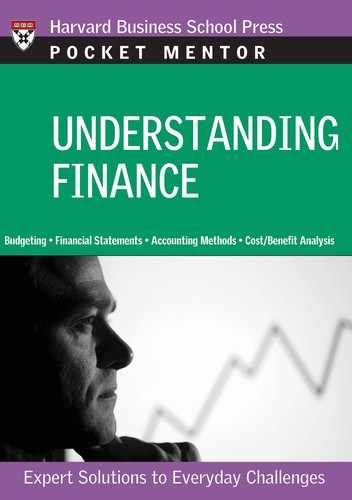Test Yourself
This section offers ten multiple-choice questions to help you identify your baseline knowledge of finance essentials. Answers to the questions are given at the end of the test.
1. If you want to recognize revenue during the period in which the related sales activity occurred, which accounting method would you use?
- Accrual accounting.
- Cash-basis accounting.
2. Which of the following would be considered a cost of goods sold?
- Administrative employee salaries.
- Sales and marketing costs.
- Rents.
- Assembly labor costs.
- Advertising costs.
3. In most finance systems, what is the time frame that distinguishes short-term liabilities, also known as current liabilities, from long-term liabilities?
- Short-term liabilities typically have to be paid in a year or less; long-term liabilities take more than a year to repay.
- Short-term liabilities typically have to be paid within eighteen months; a long-term liability takes more than eighteen months to repay.
- Short-term liabilities typically must be paid in six months or less; long-term liabilities take over six months to repay.
4. If the income statement can tell you whether a company is making a profit, what does the cash flow statement tell you?
- How efficiently a company is using its assets.
- Whether a company is turning profits into cash.
- How well a company is managing its liabilities.
5. Many analysts like to look at a ratio that shows how profitable a company’s operating activities are. Which ratio shows this?
- Acid-test ratio.
- Accounts receivable.
- EBIT margin.
6. At ABC Company, unit heads develop budgets for their departments that are linked to company performance objectives. Is this top-down or bottom-up budgeting?
- Top-down.
- Bottom-up.
7. As you begin to prepare your unit’s budget, your manager reminds you to be aware of the “scope” of your budget. What does “scope” of a budget imply?
- The context of the proposed budget: the three to five goals that the budget you are going to prepare aims to achieve.
- The part of the company the budget is supposed to cover and the level of detail it should include.
- Whether the budget includes revenues and profits as well as the operating costs of your unit.
8. When you’re preparing a cost/benefit analysis, net return and payback period analyses can help you compare and communicate the merits of different options. What, however, is the drawback to both analytic methods?
- Both net return and payback period analysis ignore the time value of money.
- Payback period and ROI do not take into account how long it will take for the investment to break even.
- ROI and payback period can only be used to evaluate potential capital investments, not other types of new business opportunities.
9. Your company is considering making an investment that could enable your division to sell more units of the Gargoyle tracking software introduced last year. Your manager has asked you to determine how likely it is that this investment will be recouped. What analytical method might give you this information?
- Sensitivity analysis.
- Breakeven analysis.
- Internal rate of return analysis (IRR).
10. To track your budget, you carry out three steps on a monthly basis. Step 2 is missing in the list below; what is it?
Step 1. Assess monthly revenue performance versus budget.
Step 2. _________________________
Step 3. Determine whether—and if so, how—your bottom line will be affected by any variances.
- Assess monthly expense performance versus budget.
- Assess monthly expense performance versus revenue performance for that same month.
- Compare monthly revenue performance with projected quarterly revenue performance.
Answers to test questions
1, a. With accrual accounting, income and expenses are recorded when they are incurred, regardless of whether cash is actually received or paid in that period. By matching revenues with expenses in the same time period, accrual accounting helps managers understand the true cause-and-effect connections between business activities.
2, d. Assembly labor costs are considered a “cost of goods sold.” Cost of goods sold includes the materials, labor, and other expenses that are directly attributable to manufacturing a product or delivering a service.
3, a. Generally, short-term liabilities have to be paid in a year or less. Long-term liabilities stretch out over a longer time period and include items such as long-term bonds and mortgages.
4, b. It is the cash flow statement that tells you whether a company is turning its profits into cash.
5, c. Many analysts use the EBIT (earnings before interest and taxes) margin, often known as the operating margin, to see how profitable the company’s operating activities are.
6, a. In top-down budgeting, senior management sets specific performance objectives for individual units. For instance, unit managers may be asked to limit expense growth to no more than 5 percent over last year’s expenses. Unit managers then develop their budgets within those parameters to ensure that the highlevel company objectives are achieved.
7, b. Scope implies two things: the part of the company your budget is supposed to cover and the level of detail it should include.
8, a. Because both methods ignore the time value of money, they do not provide as accurate an economic picture as more sophisticated tools, such as net present value and internal rate of return.
9, b. Breakeven analysis tells you how much (or how much more) of a product you need to sell in order to pay for a fixed investment—in other words, at what point you will financially break even. You can then use your sales history and knowledge of the market to determine whether the breakeven volume is achievable.
10, a. Step 2 is to assess the monthly expense performance versus budget. By understanding how revenue and expense performance compare against your budget, you can then determine whether (and how) your bottom line will be affected by any variances.
